Related Research Articles
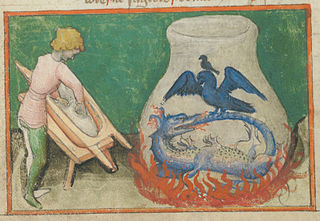
Alchemy is an ancient branch of natural philosophy, a philosophical and protoscientific tradition that was historically practiced in China, India, the Muslim world, and Europe. In its Western form, alchemy is first attested in a number of pseudepigraphical texts written in Greco-Roman Egypt during the first few centuries AD.

Amethyst is a violet variety of quartz. The name comes from the Koine Greek αμέθυστος amethystos from α- a-, "not" and μεθύσκω methysko / μεθώ metho, "intoxicate", a reference to the belief that the stone protected its owner from drunkenness. Ancient Greeks wore amethyst and carved drinking vessels from it in the belief that it would prevent intoxication.
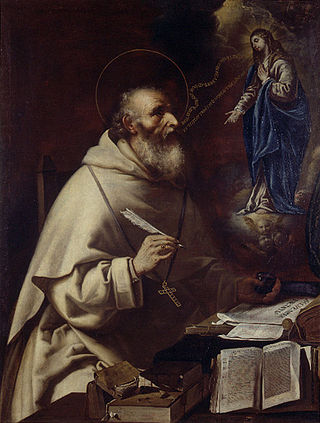
Albertus Magnus, also known as Saint Albert the Great or Albert of Cologne, was a German Dominican friar, philosopher, scientist, and bishop. Later canonized as a Catholic saint, he was known during his lifetime as Doctor universalis and Doctor expertus and, late in his life, the sobriquet Magnus was appended to his name. Scholars such as James A. Weisheipl and Joachim R. Söder have referred to him as the greatest German philosopher and theologian of the Middle Ages. The Catholic Church distinguishes him as one of the 37 Doctors of the Church.
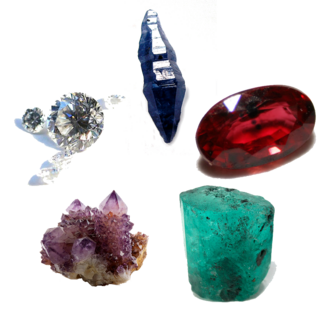
A gemstone is a piece of mineral crystal which, in cut and polished form, is used to make jewelry or other adornments. However, certain rocks and occasionally organic materials that are not minerals are also used for jewelry and are therefore often considered to be gemstones as well. Most gemstones are hard, but some soft minerals are used in jewelry because of their luster or other physical properties that have aesthetic value. Rarity and notoriety are other characteristics that lend value to gemstones.

Pseudoscience consists of statements, beliefs, or practices that claim to be both scientific and factual but are incompatible with the scientific method. Pseudoscience is often characterized by contradictory, exaggerated or unfalsifiable claims; reliance on confirmation bias rather than rigorous attempts at refutation; lack of openness to evaluation by other experts; absence of systematic practices when developing hypotheses; and continued adherence long after the pseudoscientific hypotheses have been experimentally discredited.

A ruby is a pinkish red to blood-red colored gemstone, a variety of the mineral corundum. Ruby is one of the most popular traditional jewelry gems and is very durable. Other varieties of gem-quality corundum are called sapphires. Ruby is one of the traditional cardinal gems, alongside amethyst, sapphire, emerald, and diamond. The word ruby comes from ruber, Latin for red. The color of a ruby is due to the element chromium.
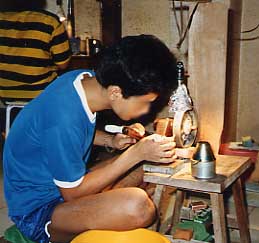
Lapidary is the practice of shaping stone, minerals, or gemstones into decorative items such as cabochons, engraved gems, and faceted designs. A person who practices lapidary is known as a lapidarist. A lapidarist uses the lapidary techniques of cutting, grinding, and polishing. Hardstone carving requires specialized carving techniques.
The Book of Healing is a scientific and philosophical encyclopedia written by Abu Ali ibn Sīna from medieval Persia, near Bukhara in Maverounnahr. He most likely began to compose the book in 1014, completed it around 1020, and published it in 1027.

Herbal medicine is the study of pharmacognosy and the use of medicinal plants, which are a basis of traditional medicine. With worldwide research into pharmacology, some herbal medicines have been translated into modern remedies, such as the anti-malarial group of drugs called artemisinin isolated from Artemisia annua, a herb that was known in Chinese medicine to treat fever. There is limited scientific evidence for the safety and efficacy of plants used in 21st century herbalism, which generally does not provide standards for purity or dosage. The scope of herbal medicine commonly includes fungal and bee products, as well as minerals, shells and certain animal parts. Herbal medicine is also called phytomedicine or phytotherapy.

Traditional medicine comprises medical aspects of traditional knowledge that developed over generations within the folk beliefs of various societies, including indigenous peoples, before the era of modern medicine. The World Health Organization (WHO) defines traditional medicine as "the sum total of the knowledge, skills, and practices based on the theories, beliefs, and experiences indigenous to different cultures, whether explicable or not, used in the maintenance of health as well as in the prevention, diagnosis, improvement or treatment of physical and mental illness". Traditional medicine is often contrasted with scientific medicine.

Medieval medicine in Western Europe was composed of a mixture of pseudoscientific ideas from antiquity. In the Early Middle Ages, following the fall of the Western Roman Empire, standard medical knowledge was based chiefly upon surviving Greek and Roman texts, preserved in monasteries and elsewhere. Medieval medicine is widely misunderstood, thought of as a uniform attitude composed of placing hopes in the church and God to heal all sicknesses, while sickness itself exists as a product of destiny, sin, and astral influences as physical causes. On the other hand, medieval medicine, especially in the second half of the medieval period, became a formal body of theoretical knowledge and was institutionalized in the universities. Medieval medicine attributed illnesses, and disease, not to sinful behaviour, but to natural causes, and sin was connected to illness only in a more general sense of the view that disease manifested in humanity as a result of its fallen state from God. Medieval medicine also recognized that illnesses spread from person to person, that certain lifestyles may cause ill health, and some people have a greater predisposition towards bad health than others.

A herbal is a book containing the names and descriptions of plants, usually with information on their medicinal, tonic, culinary, toxic, hallucinatory, aromatic, or magical powers, and the legends associated with them. A herbal may also classify the plants it describes, may give recipes for herbal extracts, tinctures, or potions, and sometimes include mineral and animal medicaments in addition to those obtained from plants. Herbals were often illustrated to assist plant identification.

Crystal healing is a pseudoscientific alternative-medicine practice that uses semiprecious stones and crystals such as quartz, agate, amethyst or opal. Adherents of the practice claim that these have healing powers, but there is no scientific basis for this claim. Practitioners of crystal healing believe they can boost low energy, prevent bad energy, release blocked energy, and transform a body's aura.
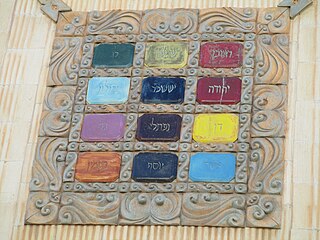
The priestly breastplate or breastpiece of judgment was a sacred breastplate worn by the High Priest of the Israelites, according to the Book of Exodus. In the biblical account, the breastplate is termed the breastplate of judgment, because the Urim and Thummim were placed upon it.(Exodus 28:30). These elements of the breastplate are said in the Exodus verse to carry the judgement of God concerning the Israelites at all times.

In the magico-medical tradition of Europe and the Near East, the aetites or aetite (anglicized) is a stone used to promote childbirth. It is also called an eagle-stone, aquiline, or aquilaeus. The stone is said to prevent spontaneous abortion and premature delivery, while shortening labor and birth for a full-term birth.

A monastic garden was used by many people and for multiple purposes. Gardening was the chief source of food for households, but also encompassed orchards, cemeteries and pleasure gardens, as well as providing plants for medicinal and cultural uses. For monasteries, gardens were especially important in supplying the monks livelihood. Primarily due to the fact that many of the plants had multiple uses: for instance, peaches were used for closing wounds.
Nicholas of Poland, also known as Nicholas of Montpellier, was a medieval Polish-German friar and healer of Silesian origin. A member of the Dominican Order, around 1250 he moved to Montpellier, where he taught in the Dominican school. Around 1270, he returned to Silesia and entered the Dominican convent at Kraków (Cracow), where he provided medical as well as spiritual care to the people.

Hardstone carving is a general term in art history and archaeology for the artistic carving of predominantly semi-precious stones, such as jade, rock crystal, agate, onyx, jasper, serpentinite, or carnelian, and for an object made in this way. Normally the objects are small, and the category overlaps with both jewellery and sculpture. Hardstone carving is sometimes referred to by the Italian term pietre dure; however, pietra dura is the common term used for stone inlay work, which causes some confusion.

A lapidary is a text in verse or prose, often a whole book, that describes the physical properties and virtues of precious and semi-precious stones, that is to say, a work on gemology. It was frequently used as a medical textbook since it also comprises practical information about each stone's medical application. Several lapidaries also provide information about countries or regions where some rocks were thought to originate, and others speculate about the natural forces in control of their formation.

Lyngurium or Ligurium is the name of a mythical gemstone believed to be formed of the solidified urine of the lynx. It was included in classical and "almost every medieval lapidary" or book of gems until it gradually disappeared from view in the 17th century.
References
- ↑ Glick, Thomas F.; Livesey, Steven; Wallis, Faith (2014). Medieval Science, Technology, and Medicine: An Encyclopedia. The Routledge Encyclopedias of the Middle Ages. Vol. 11. Routledge. p. 306. ISBN 978-1-135-45932-1.
- ↑ Albertus Magnus, The boke of secretes of Albertus Magnus of the vertues of herbes, stones, and certayne beasts : also, a boke of the same author, of the maruaylous thinges of the world, and of certaine effectes caused of certaine beastes, 1560.